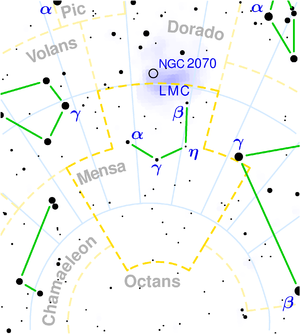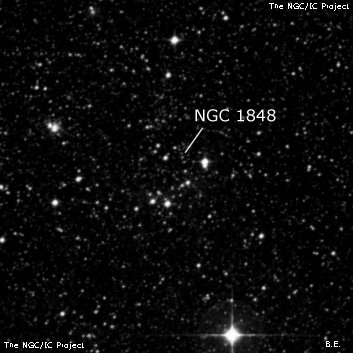 A small and faint constellation in close proximity to the south pole of the sky, therefore not visible at our latitudes. The Mensa is the faintest constellation in the sky, with the brightest stars not exceeding fifth magnitude. Four of them form the main pattern of the constellation. Of the objects of note, only the Great Magellanic Cloud is worth mentioning, which partially extends here from the neighbouring Dorado to the north.
A small and faint constellation in close proximity to the south pole of the sky, therefore not visible at our latitudes. The Mensa is the faintest constellation in the sky, with the brightest stars not exceeding fifth magnitude. Four of them form the main pattern of the constellation. Of the objects of note, only the Great Magellanic Cloud is worth mentioning, which partially extends here from the neighbouring Dorado to the north.
α Men - The yellow dwarf similar to the Sun, located relatively close to us, is 28 light-years away. In the sky, we see it as a shining point with a magnitude of 5.1.
γ Men - The brightest star of the constellation has a magnitude of 5.06. It is a giant star of spectral class K4 located 100 light years away.
β Men - A star with a magnitude of 5.3 on the edge of the Large Magellanic Cloud, but it belongs to our galaxy. It is located 200 light-years away.
η Men - A star with an apparent magnitude of 5.5, which is located 700 light-years away from us.
NGC 1848

John Herschel discovered NGC 1848 = h2776 on "the first and brightest star, 9th mag, of a cluster of loosely scattered stars" and recorded as "The first and brightest star, 9m, of a cluster of loosely scattered stars." His position is exactly 1 min of RA west of the star at the west edge of the group.
600/800mm - 30" (11/6/10 - Coonabarabran, 264x): large, scattered group of stars, winding in a loop or U-shape that is open on the east and northeast side. On the west end is a close, unequal double star with the primary being the brightest star in the cluster. In total between 30-36 stars are resolved in a 5' region (stellar assoication LH 28). At the east end of the loop is S-L 256, a faint but clumpy glow of 20" diameter. NGC 1848 is centered 6' NE of mag 7.3 HD 33923.
Notes by Steve Gottlieb